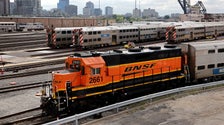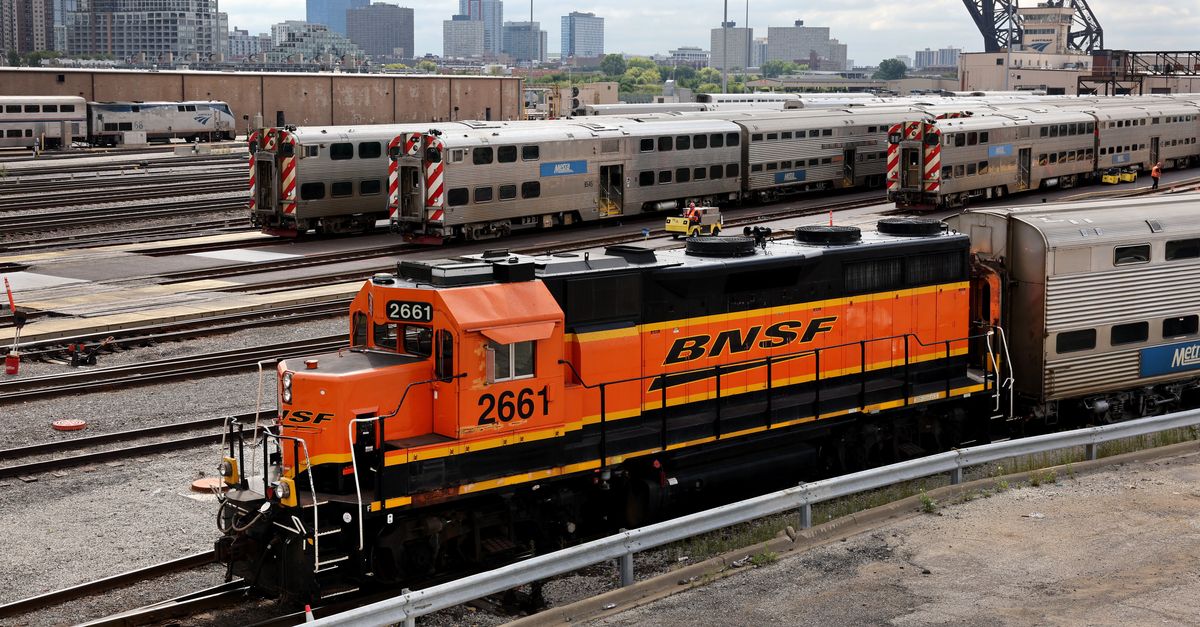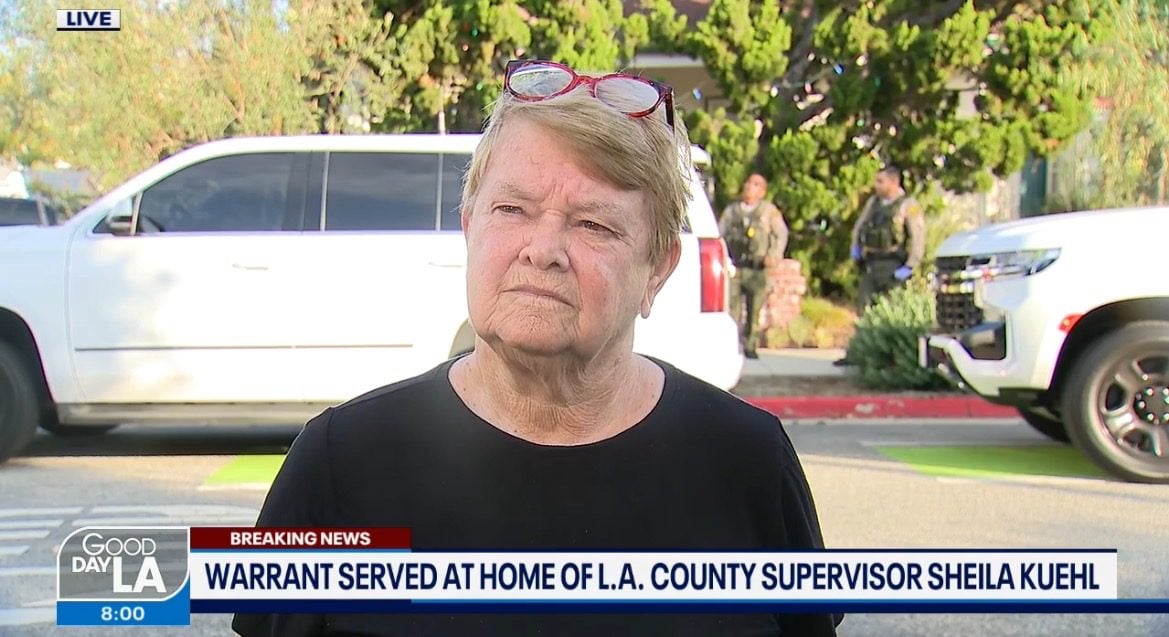
A showdown between freight rail carriers and their workers’ unions could shut down the U.S. rail system if the two sides can’t reach an agreement by Friday, which would create a disruption with vast economic and political repercussions.
A dozen unions representing more than 100,000 workers have been trying to negotiate new contracts with the major rail carriers, including Norfolk Southern, Union Pacific and CSX. While most have reached a tentative deal with the industry, two major unions still have not come to an agreement, and another union said Wednesday that its membership had voted to reject theirs.
The deadline to reach an accord is midnight Friday morning. Failing that, there are several possible outcomes.
The workers could go on strike, shutting down the freight rail system; the rail companies could lock the workers out of their jobs, achieving the same practical effect; Congress could impose contract terms on both sides whether they like it or not; or the deadline could be extended.
The impact of a shutdown could be so severe that President Joe Biden has been urging the carriers and the unions to reach a compromise as soon as possible, and Labor Secretary Marty Walsh was meeting with both sides on Wednesday morning in hopes of averting a work stoppage.
“A shutdown of our freight rail system is an unacceptable outcome for our economy and the American people, and all parties must work to avoid just that,” White House press secretary Karine Jean-Pierre told reporters.
What’s the dispute about?
A collective bargaining agreement has many moving parts to it during negotiations: wages, health care coverage, retirement benefits, paid leave, work rules and more. Those pieces can all be in flux with one another until the moment a deal is reached, but the unions say the disagreement at this point is primarily over leave and scheduling policies.
The unions say workers can end up on call for up to 14 days at a time and face draconian attendance requirements — including losing their jobs for going to the doctor or tending to sick children.
“Our members are being terminated for getting sick or for attending routine medical visits.”
– The unions SMART and BLET
In a joint statement, two of the unions at the center of the fight, the International Association of Sheet Metal, Air, Rail and Transportation Workers (SMART) and the Brotherhood of Locomotive Engineers and Trainmen (BLET), said the rail carriers’ policies amounted to “harassment.”
“Penalizing engineers and conductors for getting sick or going to a doctor’s visit with termination must be stopped as part of this contract settlement,” they said. “Let us repeat that: our members are being terminated for getting sick or for attending routine medical visits as we crawl our way out of worldwide pandemic.”
The unions insist workers have been pushed to the brink and would reject any deal that didn’t make improvements on this front. They point to staffing reductions in the industry as evidence that the employers are squeezing too much out of the workforce.
According to the federal Surface Transportation Board, major carriers have slashed staffing by 29% over six years, leading the board’s director to say that in many cases “the railroads simply do not have a sufficient number of employees.”
How did we get this close to a rail shutdown?
Because of the impact a work stoppage would have on transportation and commerce, railway workers are covered by a different labor law than most other private-sector workers. Both sides must go through several steps before workers can legally go on strike or be locked out from their jobs. It’s likely a testament to workers’ frustration that the dispute has gotten this far.
After failing to reach an agreement, the union coalitions and the rail industry group, the National Railway Labor Conference, went through months of mediation with federal officials. That didn’t end in a deal, either, and the two sides began a legally required month-long “cooling off” period. After that, Biden called together an emergency board to try to bring an end to the dispute.
The board conducted hearings and in August made its recommendations, including a 24% wage increase over the course of five years, which the rail group said would be “the most substantial wage increase in decades.” But the unions that have held out said the board erred on the leave and attendance issue, leaving the unions unwilling to accept the package.
Once another legally required cooling-off period ends on Friday morning, a work stoppage will be on the table. BLET union members told the publication Labor Notes that they plan to start a picket line at 12:01 a.m. Friday morning if they don’t have a contract. But it’s also possible that the rail carriers themselves initiate the work stoppage by locking the workers out of their jobs to gain leverage in the negotiations.
What would the effects of a shutdown be?
We are already seeing some of the effects. Amtrak announced Wednesday that it was canceling long-distance passenger trains starting Thursday, primarily outside the busy Northeast Corridor. Passenger trains would be affected because they often use tracks run by freight companies. Other transit agencies have warned that they could be hurt by a shutdown as well.
Several of the freight companies started limiting service earlier this week, putting embargoes on certain types of shipments several days before the deadline. The companies said the idea was to make sure hazardous materials don’t end up abandoned in the event of a work stoppage, but the unions criticized the move as a ploy to put political pressure on the workers.
“The railroads are using shippers, consumers, and the supply chain of our nation as pawns in an effort to get our [unions] to cave into their contract demands knowing that our members would never accept them,” SMART and BLET said in a statement.
“It’s possible that the rail carriers themselves initiate the work stoppage by locking the workers out of their jobs to gain leverage.”
The White House has been laying plans to keep critical goods moving in the event the two sides can’t reach a deal. The standoff has left the Biden administration in a tough political spot: the administration doesn’t want a work stoppage that could hurt the economy and spur more inflation, but union allies would be furious if Biden, the self-declared “most pro-union president” ever, helped push them into an unsatisfactory deal.
Both sides might agree to extend the deadline beyond Friday morning to buy more time to negotiate. It’s also theoretically possible that Congress intervenes and compels the carriers and the unions to adopt the presidential board’s contract recommendations, an outcome that carriers like BNSF would appear to be pleased with.
Republicans in the Senate maneuvered Wednesday to accomplish that through a resolution, but they were blocked by the chamber’s best-known union supporter, Sen. Bernie Sanders (I-Vt.). Speaking on the Senate floor, Sanders hammered the rail carriers for having what he called a “reactionary policy” of “denying workers sick leave.”
“What that means is if you as a worker get sick, if your child gets sick, if your spouse gets sick and you need to take time off of work, not only will you not get paid, you actually could get fired,” Sanders said. “How crazy is that?”

























































